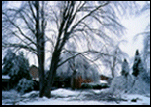|
(936)-273-2218 | (281)-419-8752 |
 |
 |
 |
 |
|||
| No matter the season, we keep you comfortable | ||||||
|
(936)-273-2218 | (281)-419-8752 |
 |
 |
 |
 |
|||
| No matter the season, we keep you comfortable | ||||||
Gas fired and forced air electric furnaces distribute warm, even heat throughout your home or place of business by heating air and circulating it through ducts.

Furnaces create heat by burning fuel (gas, oil, or propane). When the fuel burns, it generates hot gasses which travel through curved metal tubing called a heat exchanger. As air passes over the heat exchanger, it absorbs heat from the hot metal surface. The heated air is then circulated through ducts to warm your home or place of business. Meanwhile, the gasses that are created by the burning fuel are released outside through a vent pipe.
A furnace which is cracked or contains holes or small leaks can release carbon monoxide into your home or place of business. Carbon monoxide is colorless, odorless, and tasteless and is virtually impossible for the human senses to detect. Most accidental carbon monoxide poisonings occur from house fires, malfunctioning home-heating systems and hot-water heaters. While the symptoms vary significantly, the most common symptoms are headache, nausea, vomiting, dizziness and fatigue. On-going carbon monoxide poisoning may lead to coma and death.
To reduce the risk of carbon monoxide poisoning inside your home or place of business, have your furnace inspected annually by an experienced technician. An annual check-up should include a thorough inspection of the heating unit for cracks, holes, and leaks. To reduce the risk of fire, the flame should be checked for a proper mixture of air and gas. Likewise the safety and limit switches should be tested to insure that the fan runs whenever the heat exchanger is hot and that the unit will shut off should the flame burn beyond the confines of the box.

An electric heater uses an air handler (fan) to force air across a heat exchanger, a wire coil which uses electricity to create heat. The heated air is then circulated through ducts to warm your home or place of business.
While electric furnaces are generally cleaner and safer to run than gas powered furnaces, they too can benefit from an annual heating inspection to insure that they are running efficiently and that they are providing maximum comfort. The inspection may also detect minor problems which can be corrected before they cause more serious damage to your heating system.

A heat pump works by moving naturally occurring heat into your home. In summer, the heat pump reverses the process and pumps warm indoor air outdoors to cool your home. Because a heat pump does not burn fuel, it is safer and cleaner to run than a gas powered furnace. For a detailed description on how heat pumps work, visit our Heat Pumps web page.

Breathe Easy - Schedule a Heating Inspection Today
(936)-273-2218